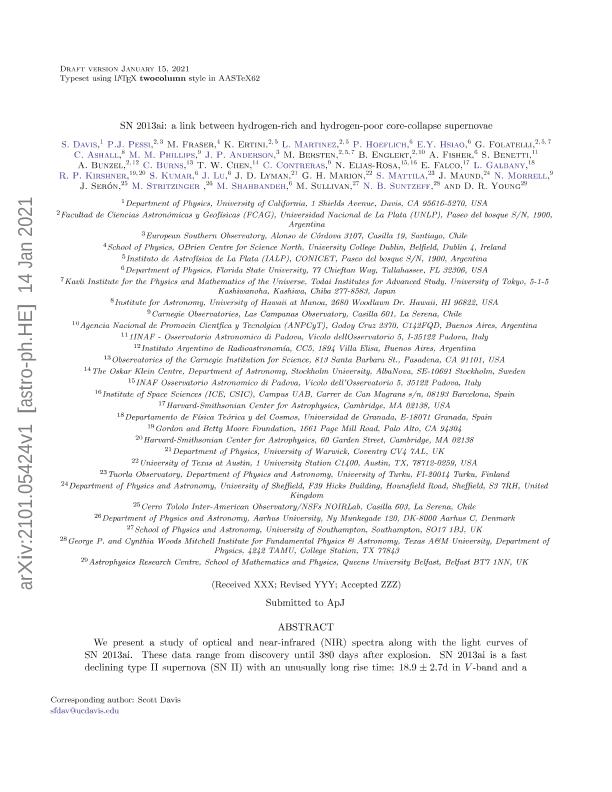Artículo
SN 2013ai: a link between Hydrogen-rich and Hydrogen-poor Core-collapse Supernovae
Davis, Scott; Pessi, Priscila Jael ; Fraser, M.; Ertini, Keila Yael
; Fraser, M.; Ertini, Keila Yael ; Martinez, Veronica Laura
; Martinez, Veronica Laura ; Hoeflich, Peter; Hsiao, Eric; Folatelli, Gaston
; Hoeflich, Peter; Hsiao, Eric; Folatelli, Gaston ; Ashall, Chris; Phillips, Mark; Anderson, J. P.; Bersten, Melina Cecilia
; Ashall, Chris; Phillips, Mark; Anderson, J. P.; Bersten, Melina Cecilia ; Englert, B.; Fisher, A.; Benetti, S.; Simaz Bunzel, Adolfo
; Englert, B.; Fisher, A.; Benetti, S.; Simaz Bunzel, Adolfo ; Burns, Christopher R.; Chen, T. W.; Contreras, Carlos; Elias Rosa, N.; Falco, E.; Galbany, Lluís; Kirshner, Robert; Kumar, S.; Lu, J.; Lyman, D.; Marion, G. H.; Mattila, S.; Maund, J.; Morrell, Nidia Irene
; Burns, Christopher R.; Chen, T. W.; Contreras, Carlos; Elias Rosa, N.; Falco, E.; Galbany, Lluís; Kirshner, Robert; Kumar, S.; Lu, J.; Lyman, D.; Marion, G. H.; Mattila, S.; Maund, J.; Morrell, Nidia Irene ; Serón, J.; Stritzinger, Maximilian; Shahbandeh, Melissa; Sullivan, Mark; Suntzeff, N. B.; Young, D. R.
; Serón, J.; Stritzinger, Maximilian; Shahbandeh, Melissa; Sullivan, Mark; Suntzeff, N. B.; Young, D. R.
 ; Fraser, M.; Ertini, Keila Yael
; Fraser, M.; Ertini, Keila Yael ; Martinez, Veronica Laura
; Martinez, Veronica Laura ; Hoeflich, Peter; Hsiao, Eric; Folatelli, Gaston
; Hoeflich, Peter; Hsiao, Eric; Folatelli, Gaston ; Ashall, Chris; Phillips, Mark; Anderson, J. P.; Bersten, Melina Cecilia
; Ashall, Chris; Phillips, Mark; Anderson, J. P.; Bersten, Melina Cecilia ; Englert, B.; Fisher, A.; Benetti, S.; Simaz Bunzel, Adolfo
; Englert, B.; Fisher, A.; Benetti, S.; Simaz Bunzel, Adolfo ; Burns, Christopher R.; Chen, T. W.; Contreras, Carlos; Elias Rosa, N.; Falco, E.; Galbany, Lluís; Kirshner, Robert; Kumar, S.; Lu, J.; Lyman, D.; Marion, G. H.; Mattila, S.; Maund, J.; Morrell, Nidia Irene
; Burns, Christopher R.; Chen, T. W.; Contreras, Carlos; Elias Rosa, N.; Falco, E.; Galbany, Lluís; Kirshner, Robert; Kumar, S.; Lu, J.; Lyman, D.; Marion, G. H.; Mattila, S.; Maund, J.; Morrell, Nidia Irene ; Serón, J.; Stritzinger, Maximilian; Shahbandeh, Melissa; Sullivan, Mark; Suntzeff, N. B.; Young, D. R.
; Serón, J.; Stritzinger, Maximilian; Shahbandeh, Melissa; Sullivan, Mark; Suntzeff, N. B.; Young, D. R.
Fecha de publicación:
03/2021
Editorial:
IOP Publishing
Revista:
Astrophysical Journal
ISSN:
0004-637X
Idioma:
Inglés
Tipo de recurso:
Artículo publicado
Clasificación temática:
Resumen
We present a study of the optical and near-infrared (NIR) spectra of SN 2013ai along with its light curves. These data range from discovery until 380 days after explosion. SN 2013ai is a fast declining Type II supernova (SN II) with an unusually long rise time, 18.9 2.7 days in the V-band, and a bright V-band peak absolute magnitude of -18.7 0.06 mag. The spectra are dominated by hydrogen features in the optical and NIR. The spectral features of SN 2013ai are unique in their expansion velocities, which, when compared to large samples of SNe II, are more than 1,000 km s-1 faster at 50 days past explosion. In addition, the long rise time of the light curve more closely resembles SNe IIb rather than SNe II. If SN 2013ai is coeval with a nearby compact cluster, we infer a progenitor zero-age main-sequence mass of ∼17 M o˙. After performing light-curve modeling, we find that SN 2013ai could be the result of the explosion of a star with little hydrogen mass, a large amount of synthesized 56Ni, 0.3-0.4 M o˙, and an explosion energy of 2.5-3.0 1051 erg. The density structure and expansion velocities of SN 2013ai are similar to those of the prototypical SN IIb, SN 1993J. However, SN 2013ai shows no strong helium features in the optical, likely due to the presence of a dense core that prevents the majority of γ-rays from escaping to excite helium. Our analysis suggests that SN 2013ai could be a link between SNe II and stripped-envelope SNe.
Palabras clave:
Core-collapse supernovae
,
Type II supernovae
,
Late stellar evolution
Archivos asociados
Licencia
Identificadores
Colecciones
Articulos(IAR)
Articulos de INST.ARG.DE RADIOASTRONOMIA (I)
Articulos de INST.ARG.DE RADIOASTRONOMIA (I)
Citación
Davis, Scott; Pessi, Priscila Jael; Fraser, M.; Ertini, Keila Yael; Martinez, Veronica Laura; et al.; SN 2013ai: a link between Hydrogen-rich and Hydrogen-poor Core-collapse Supernovae; IOP Publishing; Astrophysical Journal; 909; 2; 3-2021; 1-24
Compartir
Altmétricas



